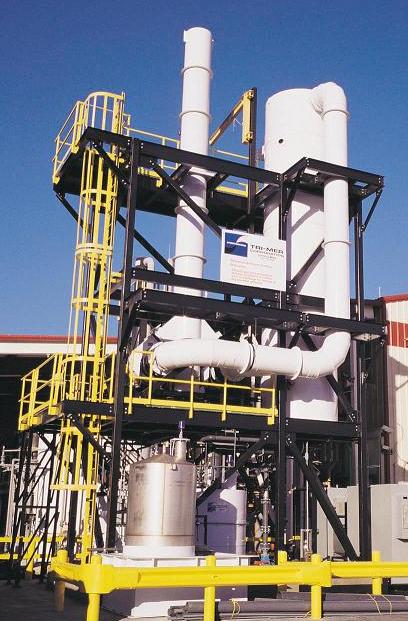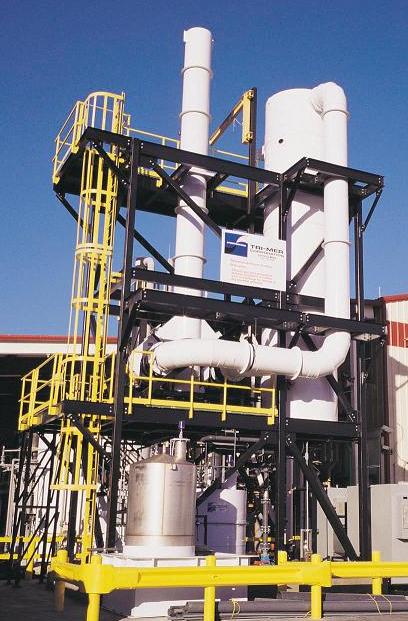Once the gas has arrived at the gas plant, it is treated to ensure that the gas fulfills pipeline specifications and meets environmental, health, and safety standards. The acid gas removal process is also known as gas sweetening, as it involves the removal of carbon dioxide and hydrogen sulfide that make the gas ‘sour’.
Hydrogen sulfide is a highly toxic compound that forms a weak corrosive acid when in contact with water. High concentrations of hydrogen sulfide may result in death in a matter of minutes, making it a top priority in the gas treatment. Carbon dioxide, which is acidic in the presence of water, is non-flammable, although large concentrations are undesirable in fuel and must be removed through treatment. Only trace amounts of contaminants may be acceptable in processed gas that is sent to pipelines. Acid gas can be removed chemically or physically through solvent absorption, by solid adsorption, membranes, and cryogenic processing. The type of processing selected depends mainly on the temperature, pressure, and composition of contaminants of the sour gas, volume of gas to be processed, specifications of the residue gas, etc.
Absorption
Absorption can be conducted using a physical or chemical solvent. Common examples of chemical solvents used in absorption of contaminants are aqueous solutions of alkanol amine such as monoethanolamine (MEA), diethanolamine (DEA), diisopropanolamine (DIPA), and methyldiethanolamine (MDEA). The selection of solvent type is based on the initial acid gas content of the feed and the desired acid gas partial pressure in the product. The major cost factors of absorption are the solvent circulation rate and the energy requirement to regenerate the solvent.
For chemical absorption, liquid amine is used to treat the sour gas, as dissolved gas reacts weakly with basic amines. This absorption is controlled by the partial pressures of hydrogen sulfide and carbon dioxide in the gas, while the reactions in the liquid phase are controlled by the reactivity of the dissolved gases. A typical acid gas removal unit for absorption involves an absorber that acts as a contactor. Acid gas enters the tray or packed column contactor at the bottom stage and comes into contact with the lean amine flowing down from the top stage. From this contact, contaminant-rich amine exits from the bottom, and contaminant-free gas exits out the top of the contactor. The column can operate to pressures up to 70 bar at higher than ambient temperatures due to the exothermic heat of absorption of the reaction occurring in the column.
The rich amine is then depressurized using a valve before entering a flash tank so any dissolved hydrocarbons in the amine are flashed. The rich amine is then heated in a heat exchanger prior to entering a regenerator column acting as a stripper. The rich amine enters from the top of the column and is contacted with steam coming from the reboiler. The vapor strips off acid gas from the amine as the liquid travels down the column. Lean amine exits out the bottom of the column and the vapor, consisting of mostly acid gas and water vapor, is sent for further processing for sulfur recovery. The hot lean amine from the reboiler passes through a series of cooling processes and is pumped back to the contactor.
In physical absorption, on the other hand, the main driving force is the partial pressure of the acid gases, and the gas solubility and partition coefficients of the species. The acid gas is cooled before it enters the absorber from the bottom stage, while the solvent, usually glycol, enters from the top stage. The high-pressure exiting solvent then passes through a series of separator vessels to flash any dissolved gas, where its pressure is eventually lowered down to vacuum pressure before being cooled to re-enter the absorber.
Acknowledgements
- Tri-Mer Corporation
References
- Mokhatab, S.; Poe, W. A.; & Mak, J. Y. Handbook of Natural Gas Transmission and Processing. Boston: Gulf Professional Publishing, 2015, 191-217
- Kidnay, A.; Parrish, W. Fundamentals of Natural Gas Processing. Boca Raton: CRC Press, 2006
- Carroll, J. Natural Gas Hydrates – A Guide for Engineers; 3rd ed.; Elsevier, 2018.
- Engineering data book: volumes I & II: SI version; Gas Processors Suppliers Association: Tusla, OK, 2012.
Developers
- Nuramani Saiyidah Binti Ramli


